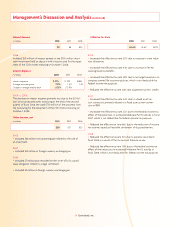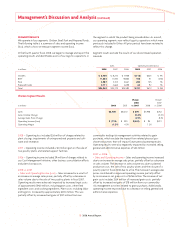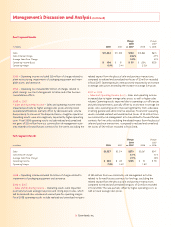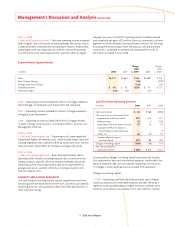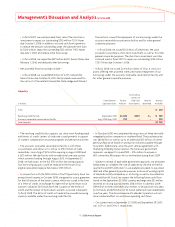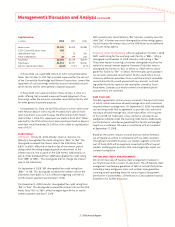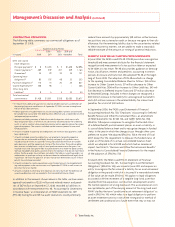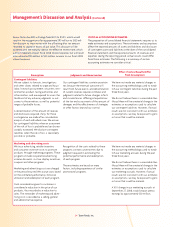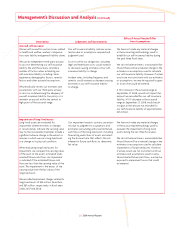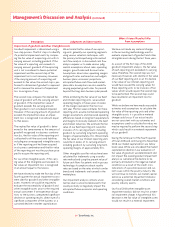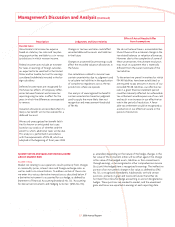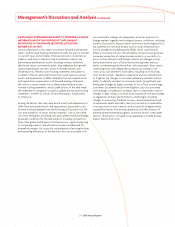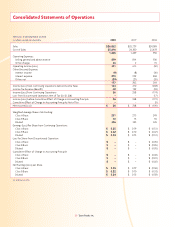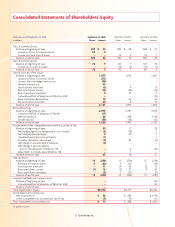Tyson Foods 2008 Annual Report Download - page 24
Download and view the complete annual report
Please find page 24 of the 2008 Tyson Foods annual report below. You can navigate through the pages in the report by either clicking on the pages listed below, or by using the keyword search tool below to find specific information within the annual report.
22 Tyson Foods, Inc.
Management’s Discussion and Analysis (continued)
CONTRACTUAL OBLIGATIONS
The following table summarizes our contractual obligations as of
September 27, 2008:
Payments Due by Period
2010– 2012– 2014 and
in millions 2009 2011 2013 thereafter Total
Debt and capital
lease obligations:
Principal payments(1) $ 8 $1,245 $ 5 $1,638 $2,896
Interest payments(2) 289 339 207 329 1,164
Guarantees(3) 25 29 33 34 121
Operating lease
obligations(4) 80 102 48 23 253
Purchase obligations(5) 710 73 20 24 827
Capital expenditures(6) 308 58 – – 366
Other long-term
liabilities(7) 8 5 5 32 50
Total contractual
commitments $1,428 $1,851 $318 $2,080 $5,677
(1) In the event of a default on payment or violation of debt covenants, acceleration of
the principal payments could occur. At September 27, 2008, we were in compliance
with all of our debt covenants.
(2) Interest payments included interest on all outstanding debt. Payments are estimated
for variable rate and variable term debt based on effective rates at September 27, 2008,
and expected payment dates.
(3) Amounts included guarantees of debt of outside third parties, which consist of a
lease and grower loans, all of which are substantially collateralized by the underlying
assets, as well as residual value guarantees covering certain operating leases for various
types of equipment. The amounts included are the maximum potential amount of
future payments.
(4) Amounts included in operating lease obligations are minimum lease payments under
lease agreements.
(5) Amounts included in purchase obligations are agreements to purchase goods or
services that are enforceable and legally binding and specify all signifi cant terms,
including: fi xed or minimum quantities to be purchased; fi xed, minimum or variable
price provisions; and the approximate timing of the transaction. The purchase obliga-
tions amount included items, such as future purchase commitments for grains, live-
stock contracts and fi xed grower fees that provide terms that meet the above criteria.
We have excluded future purchase commitments for contracts that do not meet these
criteria. Purchase orders have not been included in the table, as a purchase order is an
authorization to purchase and may not be considered an enforceable and legally bind-
ing contract. Contracts for goods or services that contain termination clauses without
penalty have also been excluded.
(6) Amounts included in capital expenditures are estimated amounts to complete build-
ings and equipment under construction as of September 27, 2008, as well as costs to
construct Dynamic’s facility.
(7) Amounts included in other long-term liabilities are items that meet the defi nition of
a purchase obligation and are recorded in the Consolidated Balance Sheets.
In addition to the amounts shown above in the table, we have unrec-
ognized tax benefi ts of $220 million and related interest and penal-
ties of $67 million at September 27, 2008, recorded as liabilities in
accordance with Interpretation No. 48, “Accounting for Uncertainty
in Income Taxes,” an interpretation of FASB Statement No. 109
(FIN 48). During fi scal 2009, tax audit resolutions could potentially
reduce these amounts by approximately $38 million, either because
tax positions are sustained on audit or because we agree to their dis-
allowance. For the remaining liability, due to the uncertainties related
to these income tax matters, we are unable to make a reasonably
reliable estimate of the amounts or timing of potential reductions.
RECENTLY ADOPTED ACCOUNTING PRONOUNCEMENTS
In June 2006, the FASB issued FIN 48. FIN 48 prescribes a recognition
threshold and measurement attribute for the fi nancial statement
recognition and measurement of a tax position taken or expected
to be taken in a tax return. FIN 48 also provides guidance on derecog-
nition, classifi cation, interest and penalties, accounting in interim
periods, disclosure and transition. We adopted FIN 48 at the begin-
ning of fi scal 2008. The adoption of FIN 48 resulted in a change
to the opening Consolidated Balance Sheet as follows: $32 million
increase to Other Current Assets, $17 million decrease to Other
Current Liabilities, $106 million increase to Other Liabilities, $40 mil-
lion decrease to Deferred Income Taxes and $17 million decrease
to Retained Earnings. Included in these changes we recognized a
$120 million increase in the liability for unrecognized tax benefi ts
and a $21 million increase in the related liability for interest and
penalties for a total of $141 million.
In September 2006, the FASB issued Statement of Financial
Accounting Standards No. 158, “Employers’ Accounting for Defi ned
Benefi t Pension and Other Postretirement Plans, an amendment
of FASB Statements No. 87, 88, 106, and 132(R)” (SFAS No. 158).
SFAS No. 158 requires companies to recognize the funded status
of a defi ned benefi t postretirement plan as an asset or liability in
its consolidated balance sheet and to recognize changes in funded
status in the year in which the changes occur through other com-
prehensive income. We adopted SFAS No. 158 at the end of fi scal
2007 except for the requirement to measure the funded status of
a plan as of the date of its annual consolidated balance sheet,
which we adopted in fi scal 2008 and which had an immaterial
impact. See Note 13, “Pensions and Other Postretirement Benefi ts”
in the Notes to Consolidated Financial Statements for the impact
of the adoption of SFAS No. 158.
In March 2005, the FASB issued FIN 47. Statement of Financial
Accounting Standards No. 143, “Accounting for Asset Retirement
Obligations” (SFAS No. 143), was issued in June 2001 and requires an
entity to recognize the fair value of a liability for an asset retirement
obligation in the period in which it is incurred if a reasonable estimate
of fair value can be made. SFAS No. 143 applies to legal obligations
associated with the retirement of a tangible long-lived asset that
resulted from the acquisition, construction, development and/or
the normal operation of a long-lived asset. The associated asset costs
are capitalized as part of the carrying amount of the long-lived asset.
FIN 47 clarifi es the term “conditional asset retirement obligation” as
used in SFAS No. 143, which refers to a legal obligation to perform
an asset retirement activity in which the timing and/or method of
settlement are conditional on a future event that may or may not




